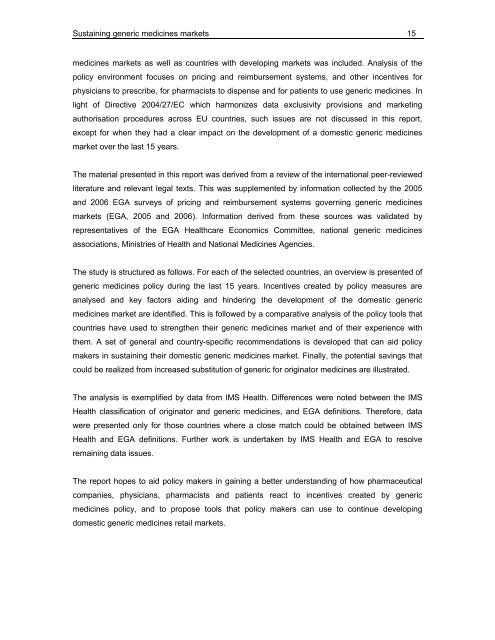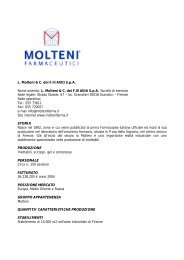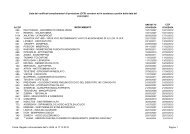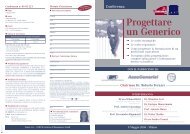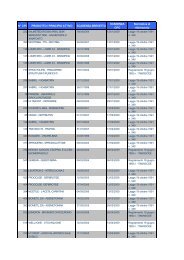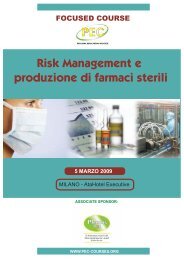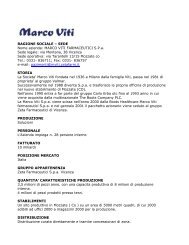Sustaining Generic Medicines Markets in Europe
Sustaining Generic Medicines Markets in Europe
Sustaining Generic Medicines Markets in Europe
Create successful ePaper yourself
Turn your PDF publications into a flip-book with our unique Google optimized e-Paper software.
<strong>Susta<strong>in</strong><strong>in</strong>g</strong> generic medic<strong>in</strong>es markets 15medic<strong>in</strong>es markets as well as countries with develop<strong>in</strong>g markets was <strong>in</strong>cluded. Analysis of thepolicy environment focuses on pric<strong>in</strong>g and reimbursement systems, and other <strong>in</strong>centives forphysicians to prescribe, for pharmacists to dispense and for patients to use generic medic<strong>in</strong>es. Inlight of Directive 2004/27/EC which harmonizes data exclusivity provisions and market<strong>in</strong>gauthorisation procedures across EU countries, such issues are not discussed <strong>in</strong> this report,except for when they had a clear impact on the development of a domestic generic medic<strong>in</strong>esmarket over the last 15 years.The material presented <strong>in</strong> this report was derived from a review of the <strong>in</strong>ternational peer-reviewedliterature and relevant legal texts. This was supplemented by <strong>in</strong>formation collected by the 2005and 2006 EGA surveys of pric<strong>in</strong>g and reimbursement systems govern<strong>in</strong>g generic medic<strong>in</strong>esmarkets (EGA, 2005 and 2006). Information derived from these sources was validated byrepresentatives of the EGA Healthcare Economics Committee, national generic medic<strong>in</strong>esassociations, M<strong>in</strong>istries of Health and National <strong>Medic<strong>in</strong>es</strong> Agencies.The study is structured as follows. For each of the selected countries, an overview is presented ofgeneric medic<strong>in</strong>es policy dur<strong>in</strong>g the last 15 years. Incentives created by policy measures areanalysed and key factors aid<strong>in</strong>g and h<strong>in</strong>der<strong>in</strong>g the development of the domestic genericmedic<strong>in</strong>es market are identified. This is followed by a comparative analysis of the policy tools thatcountries have used to strengthen their generic medic<strong>in</strong>es market and of their experience withthem. A set of general and country-specific recommendations is developed that can aid policymakers <strong>in</strong> susta<strong>in</strong><strong>in</strong>g their domestic generic medic<strong>in</strong>es market. F<strong>in</strong>ally, the potential sav<strong>in</strong>gs thatcould be realized from <strong>in</strong>creased substitution of generic for orig<strong>in</strong>ator medic<strong>in</strong>es are illustrated.The analysis is exemplified by data from IMS Health. Differences were noted between the IMSHealth classification of orig<strong>in</strong>ator and generic medic<strong>in</strong>es, and EGA def<strong>in</strong>itions. Therefore, datawere presented only for those countries where a close match could be obta<strong>in</strong>ed between IMSHealth and EGA def<strong>in</strong>itions. Further work is undertaken by IMS Health and EGA to resolverema<strong>in</strong><strong>in</strong>g data issues.The report hopes to aid policy makers <strong>in</strong> ga<strong>in</strong><strong>in</strong>g a better understand<strong>in</strong>g of how pharmaceuticalcompanies, physicians, pharmacists and patients react to <strong>in</strong>centives created by genericmedic<strong>in</strong>es policy, and to propose tools that policy makers can use to cont<strong>in</strong>ue develop<strong>in</strong>gdomestic generic medic<strong>in</strong>es retail markets.


